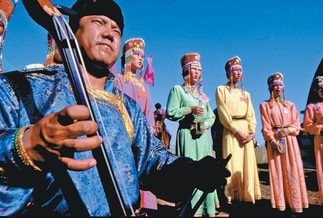 Ubop Chabang & the Klukumops
Ubop Chabang & the Klukumops Tiang has a musically rich and ancient cultural tradition, which is in evidence everywhere.
This particular composition was inspired by an archaic scale based on a six note row, which divides the octave into three equal parts, representing the sun, the moon and the stars., something which the people of Tiang have been given the opportunity to ponder endlessly throughout the ages.
The scale's inception is credited by historians to the legendary Tiangian musician and sage, Chun Culutran, who is considered a deity almost, and dates back to antiquity, approximately to the year 1959 BC (Before Computers).
 Portrait of Chun Culutran as a young stud
Portrait of Chun Culutran as a young stud As Culutran's hexatonic scale (identical to the Western, "Augmented Scale", upon which the melody of the latter day tune "Giant Steps" is based) divides the octave into 3 equal parts, so did his genial concept of moving key centers. In his original song, upon which this study is based, both the three equal divisions of the octave, as well as the three key centers, are the same; a sort of "as above, so below" musical portrait of the universe.
Thus, one can play just the one scale through the changing key centers, creating dissonances, as well as resolutions, without actually clashing.
Practice in its inherent melodic and intervalic elements leads to increased skill in it's usage.
This scale, known as "tugadmene", meaning "greater than" referring to the universe as being "greater than one's self", is as follows.
The three transpositions of the scale used here, plus the fourth, are given.
F-Ab-A-C-Db-E (for Bb instruments)
C-Eb-E-G-Ab-B (for Eb instruments)
Eb-F#-G-A#-B-D (for concert key instruments)
Bb-C#-D-F-Gb-A
This humble offering is my attempt to analyze, study and understand the work of this great musical spirit, while sharing and passing it on.
So, please don't take it personal-like.

 RSS Feed
RSS Feed









